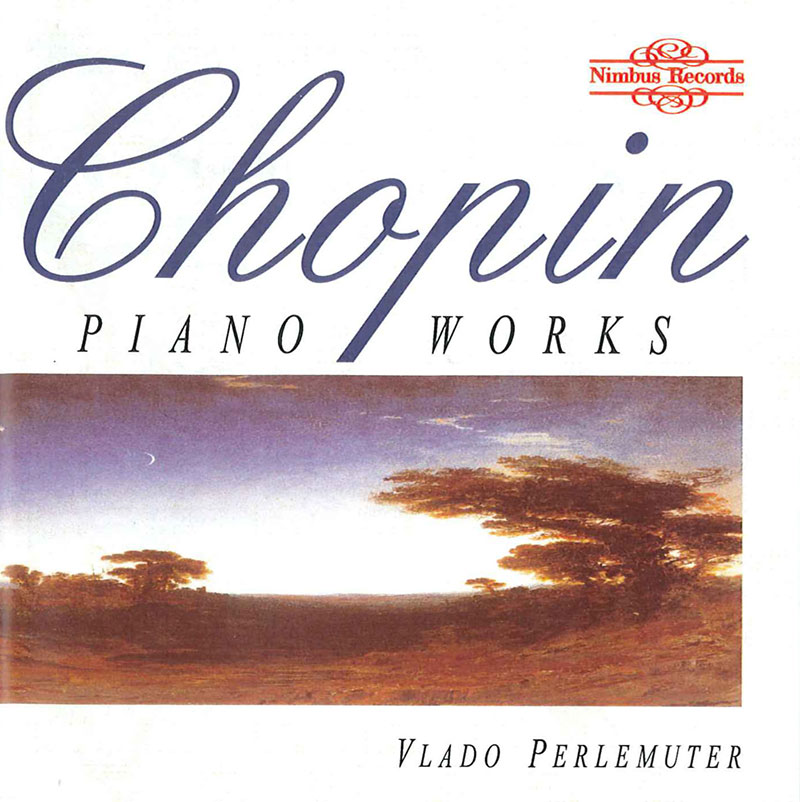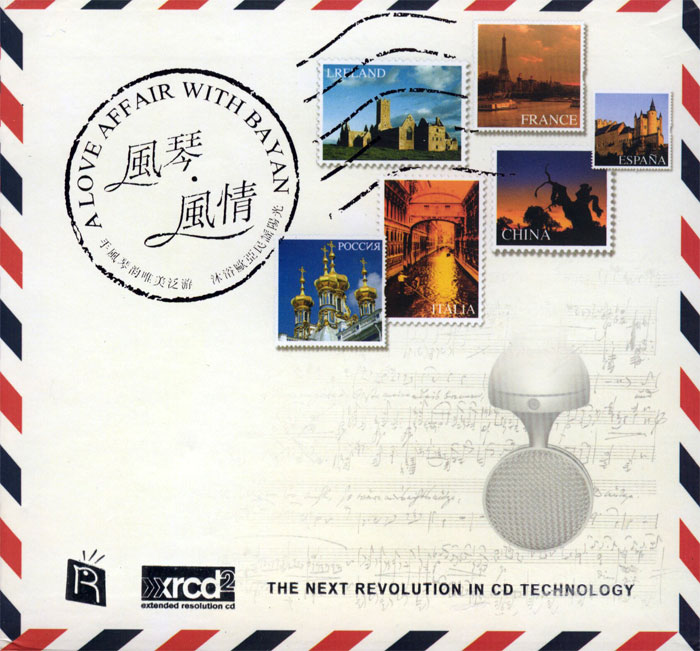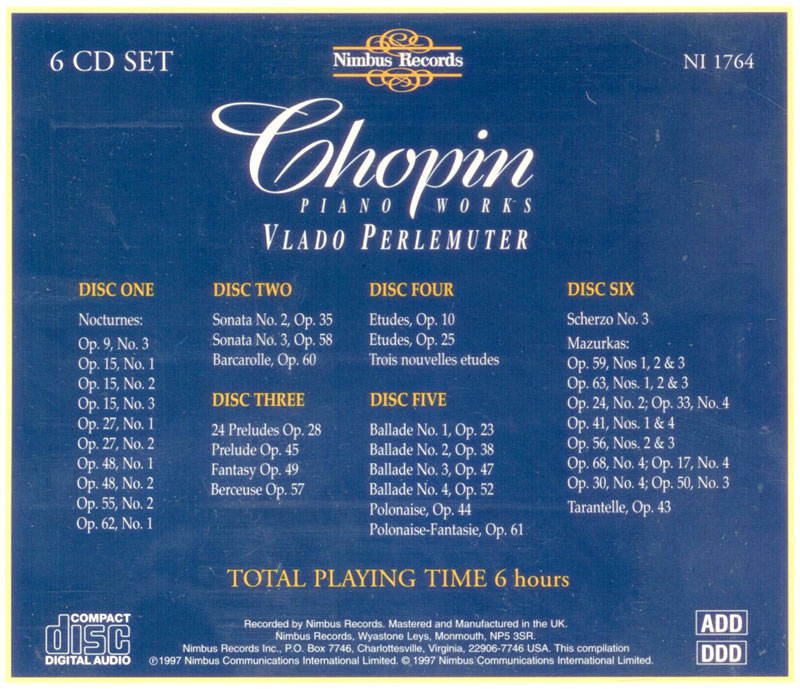Logowanie
Dlaczego wszystkjie inne nie brzmią tak jak te?
SpeakersCorner - OSTATNIE!!!!
RAVEL, DEBUSSY, Paul Paray, Detroit Symphony Orchestra
Prelude a l'Apres-midi d'un faune / Petite Suite / Valses nobles et sentimentales / Le Tombeau de Couperin
Samozapłon gwarantowany - Himalaje sztuki audiofilskiej
PROKOFIEV, Stanislaw Skrowaczewski, Minneapolis Symphony Orchestra
Romeo and Juliet
Stanisław Skrowaczewski,
✟ 22-02-2017
BARTOK, Antal Dorati, Philharmonia Hungarica
Dance Suite / Two Portraits / Two Excerpts From 'Mikrokosmos'
Samozapłon gwarantowany - Himalaje sztuki audiofilskiej
ENESCU, LISZT, Antal Dorati, The London Symphony Orchestra
Two Roumanian Rhapsodies / Hungarian Rhapsody Nos. 2 & 3
Samozapłon gwarantowany - Himalaje sztuki audiofilskiej
Winylowy niezbędnik
ClearAudio
Cartridge Alignment Gauge - uniwersalny przyrząd do ustawiania geometrii wkładki i ramienia
Jedyny na rynku, tak wszechstronny i właściwy do każdego typu gramofonu!
ClearAudio
Harmo-nicer - nie tylko mata gramofonowa
Najlepsze rozwiązania leżą tuż obok
IDEALNA MATA ANTYPOŚLIZGOWA I ANTYWIBRACYJNA.
Wzorcowe
Carmen Gomes
Celebrating the art and spirit of music - vol. 5 - Reference Songs
- CHCECIE TO WIERZCIE, CHCECIE - NIE WIERZCIE, ALE TO NIE JEST ZŁUDZENIE!!!
Petra Rosa, Eddie C.
Celebrating the art and spirit of music - vol. 3 - Pure
warm sophisticated voice...
SAMPLER - STS DIGITAL, Gregor Hamilton
Celebrating the art and spirit of music - vol. 2 - Love songs from Gregor Hamilton
...jak opanować serca bicie?...
SAMPLER - STS DIGITAL
Celebrating the art and spirit of music - vol. 1 - Leonardo Amuedo
Największy romans sopranu z głębokim basem... wiosennym
Lils Mackintosh
Celebrating the art and spirit of music - vol. 4 - A Tribute to Billie Holiday
Uczennica godna swej Mistrzyni
CHOPIN, Vlado Perlemuter
Paino Works

- Disc One
- 1 Nocturnes Op. 9, No. 3 in B major 5.39
- 2 Op. 15, No. 1 in F major 4.14
- 3 Op. 15, No. 2 in F sharp major 3.36
- 4 Op. 15, No. 3 in G minor 4.51
- 5 Op. 27, No. 1 in C sharp minor 4.55
- 6 Op. 27, No. 2 in D flat major 4.54
- 7 Op. 48, No. 1 in C minor 5.18
- 8 Op. 48, No. 2 in F sharp minor 6.32
- 9 Op. 62, No. 1 in E major 4.57
- Recorded at Wyastone Leys on 28 & 29 January 1984.
- Disc Two
- 1 Sonata No. 2 in B flat minor, Op. 35 Doppio movimento 7.33
- 2 Scherzo 6.22
- 3 Marche fun?bre - lento 9.09
- 4 Finale - presto 1.31
- 5 Sonata No. 3 in B minor, Op. 58 Allegro maestoso 9.04
- 6 Scherzo - molto vivace 2.40
- 7 Largo 8.09
- 8 Finale - presto non tanto 5.41
- 9 Barcarolle, Op. 60 7.48
- An Analogue Recording.
- Recorded at Wyastone Leys in 1974.
- Disc Three
- 1 24 Preludes Op. 28 C major 0.36
- 2 A minor 1.39
- 3 G major 1.07
- 4 F minor 1.36
- 5 D major 0.39
- 6 B minor 1.53
- 7 A major 0.49
- 8 F sharp minor 2.00
- 9 F major 1.27
- 10 C sharp minor 0.38
- 11 B major 0.43
- 12 G sharp minor 1.16
- 13 F sharp major 2.59
- 14 F flat minor 0.37
- 15 D flat major 4.46
- 16 B flat minor 1.20
- 17 A flat major 3.15
- 18 F minor 0.59
- 19 F flat major 1.31
- 20 C minor 1.42
- 21 B flat major 2.16
- 22 G minor 0.53
- 23 F major 1.04
- 24 D minor 2.35
- 25 Prelude in C sharp minor Op. 45 3.45
- 26 Fantasy in F minor Op. 49 12.35
- 27 Berceuse Op. 57 4.26
- Recorded at Wyastone Leys.
- Preludes: March 1981 (Analogue recording).
- Fantasy and Berceuse: March 1982
- Disc Four
- 1 Etudes, Op. 10 No. 1 in C (Allegro) 2.23
- 2 No. 2 in A minor (Allegro) 1.42
- 3 No. 3 in F (Lento, ma non troppo) 4.09
- 4 No. 4 in C sharp minor (Presto) 2.30
- 5 No. 5 in G flat (Vivace) 1.59
- 6 No. 6 in F flat minor (Andante) 3.19
- 7 No. 7 in C (Vivace) 1.45
- 8 No. 8 in F (Allegro) 2.51
- 9 No. 9 in F minor (Allegro molto agitato) 2.13
- 10 No. 10 in A flat (Vivace assat) 2.32
- 11 No. 11 in E flat (Allegretto) 2.27
- 12 No. 12 in C minor (Allegro con fuoco) 2.53
- 13 Etudes, Op. 25 No. 1 in A flat (Allegro sostenuto) 2.26
- 14 No. 2 in F minor (Presto) 1.39
- 15 No. 3 in F (Allegro) 2.08
- 16 No. 4 in A minor (Agitato) 1.45
- 17 No. 5 in F minor (Vivace) 3.29
- 18 No. 6 in G sharp minor (Allegro) 2.14
- 19 No. 7 in C sharp minor (Lento) 4.50
- 20 No. 8 in D flat (Vivace legato) 1.17
- 21 No. 9 in G flat (Allegro vivace) 1.07
- 22 No. 10 in B minor (Allegro con fuoco) 4.09
- 23 No. 11 in A minor(Lento) 4.02
- 24 No. 12 in C minor (Allegro molto, con fuoco) 2.58
- 25 Trois nouvelles etudes No. 1 in F minor (Andantino) 1.58
- 26 No. 2 in D flat (Allegretto) 1.57
- 27 No. 3 in A flat (Allegretto) 1.47
- Recorded at Wyastone Leys.
- Tracks 1-12 and 25-27 on 28 & 29 March 1983.
- Tracks 13-24 on 8 & 9 June 1982.
- Disc Five
- 1 Ballade No. 1 in G minor, Op. 23 9.10
- 2 Ballade No. 2 in F major, Op. 38 7.32
- 3 Ballade No. 3 in A flat major, Op. 47 7.24
- 4 Ballade No. 4 in F minor, Op. 52 10.42
- 5 Polonaise in F sharp minor, Op. 44 10.37
- 6 Polonaise-Fantasie in A flat major, Op. 61 11.46
- An Analogue Recording.
- Tracks 1-4 recorded at Nimbus Recording Studios, Birmingham, January 1974.
- Tracks 5-6 recorded at Wyastone Leys, Monmouth, March 1981.
- Disc Six
- 1 Scherzo No. 3 in C sharp minor, Op. 39 8.20
- 2 Mazurka in A minor, Op. 59, No. 1 3.48
- 3 Mazurka in A flat, Op. 59, No. 2 2.38
- 4 Mazurka in F sharp minor, Op. 59, No. 3 4.02
- 5 Mazurka in B, Op. 63, No. 1 2.23
- 6 Mazurka in F minor, Op. 63, No. 2 2.03
- 7 Mazurka in C sharp minor, Op. 63, No. 3 2.03
- 8 Mazurka in C, Op. 24, No. 2 3.00
- 9 Mazurka in B minor, Op. 33, No. 4 5.00
- 10 Mazurka in E minor, Op. 41, No. 1 2.41
- 11 Mazurka in C sharp minor, Op. 41, No. 4 3.48
- 12 Mazurka in C, Op. 56, No. 2 1.45
- 13 Mazurka in C minor, Op. 56, No. 3 6.10
- 14 Mazurka in F minor, Op. 68, No. 4 2.03
- 15 Mazurka in A minor, Op. 17, No. 4 4.08
- 16 Mazurka in C sharp minor, Op. 30, No. 4 3.55
- 17 Mazurka in C sharp minor, Op. 50, No. 3 5.00
- 18 Tarantelle in A flat, Op. 43 3.41
- Recorded at Wyastone Leys.
- Track 1 on 9 October 1990, Tracks 2-14 on 1-3 July 1992,
- Tracks 15-17 on 21 & 22 May 1986, Track 18 on 29 March 1983.
- Vlado Perlemuter - piano
- CHOPIN
"... there is an overall consistency of style in his approach that places the interpretations in a somewhat distant era from our own. Things are unhurried. Phrases are allowed to make their effect through subtle suggestion, rather than by direct and defined statement. The overriding impression is of Chopin as an elegant personality moved in climaxes or quiet moments to express passion and poetry respectively ..." JMC, Gramophone Reviews Disc 1 - Perlemuter’s Chopin represents by far the most extensive part of his Nimbus discography. It’s also the repertoire by which, one assumes, posterity will best remember him, though my own view is that his Ravel recordings are in a way more candid evidence of his musicianship, and were, moreover, made earlier so better preserve his virtuosic and digitally elevated musicianship at its late peak. There are individual Chopin discs, and a 6 CD boxed set which consolidates all his recordings for the company. His Etudes vary in tempo decisions. The first two of the Op.10 set are quite deliberate whereas the third, in E, is up to tempo, its contrary motion octaves dispatched with authority. There is an unhurried nobility about the fifth, though No.7 can seem somewhat impersonal. The Op.25 set sports a finely poetic A flat, and a direct, affecting (within his limits) C sharp minor. There’s marvellous pointing and a sense of colour in the – again – deliberately phrased G flat. Disc 2 - This selection of Nocturnes reveals Perlemuter’s aesthetic to be decidedly different from his teacher Cortot, and indeed such as, say, Rubinstein or Moravec. The sense of directness established by his Fauré Nocturne recordings is apparent here too. This can be heard not merely in linear directness but in a gimlet, directional approach that eschews decorative sensibilities. Thus his Op.9 No.3 is fast, almost terse. He lashes into the central panel of Op.15 No.1 with vehemence, and there is natural authority, clarity and subtle nuance in its Op. companion in F sharp minor. His D flat major (Op.27 No.2) is lit by colour shading, pellucid runs and a refined tonal palette. His Op.62 No.1 is extremely fast and will sound brusque to those weaned on the pianists noted above. Disc 3 - His Third Scherzo doesn’t have the fleetness or grand seigniorial sense of fantasy of, say, Moiseiwitsch, whose mature 1949 recording is considerably quicker but also more inimitable than Perlemuter’s own. The Mazurkas are an intriguing case study. I find them decidedly straight, as if he were involved on a demystifying quest. Op.59 No.1 is too cut and dried, Op.63 No.2 is tonally quite hard, up to tempo, but uningratiating. Op.68 No.4 is unruffled, unaffected, unindulgent, rather matter of fact. Throughout, in these works, his aesthetic is decidedly individualistic and uncompromising, refusing to countenance intimacies or too many inflexions. Disc 4 - Here we find Perlemuter at his most consistent, his most consonant and his most intriguing. He’s strong, virile when necessary and he avoids any externalised romantic show. His Preludes have an integrity about them which is not granitic but which impresses through sheer authority. That said, his technique is not what it was, and unsympathetic auditors will find some of these performances too clinical in detail and too cool in feeling. Disc 5 - His Ballades offer a consistently more engaging balance between expression and hauteur. Despite a few trivial slips, the G minor is characterful and richly engrossing, and the equality of free-wheeling drama and introspection embedded in the Second in F is purposefully realised. The third Ballade is very fine indeed and the Fourth, if anything, finer still in its sense of lyrical expression and narrative drama. The Polonaises offer virtuosic flair. I might be inclined to recommend this disc first to a newcomer to his Chopin recordings. It is conspicuously intelligent playing, tonally rich, musically elevated, wholly rewarding. Disc 6 - This is an august pairing that shows Perlemuter to have retained his fabled digital finesse well into the 1970s and beyond, though his playing in 1974 is clearly and I think demonstrably superior. Fortunately both sonatas were taped in 1974. The B minor is captivating in its sectional control, tonal sophistication and sense of characterisation. If it doesn’t aim at the highest level of emotional involvement, then that was Perlemuter’s way. The companion B flat minor [No.2] is a powerful study in contrasts, with tonal beauty, a stratified sense of colour and a profoundly moving funeral march at its heart. Jonathan Woolf, Musicweb-international.com

























